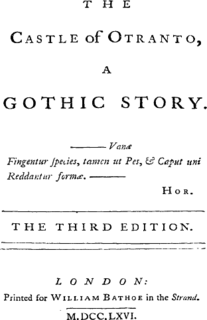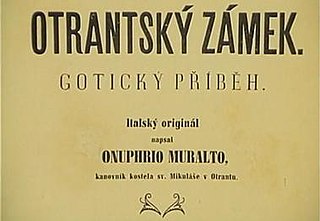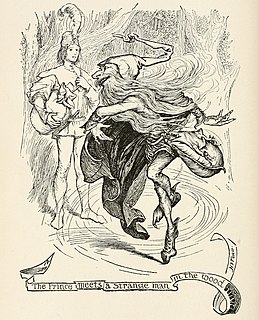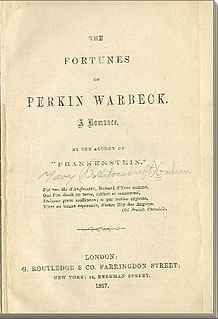
Gothic fiction, sometimes called Gothic horror in the 20th century, is a loose literary aesthetic of fear and haunting. The name is a reference to Gothic architecture of the European Middle Ages, which was characteristic of the settings of early Gothic novels. The first work to call itself Gothic was Horace Walpole's 1764 novel The Castle of Otranto, later subtitled "A Gothic Story". Subsequent 18th century contributors included Clara Reeve, Ann Radcliffe, William Thomas Beckford and Matthew Lewis. The Gothic influence continued into the early 19th century, works by the Romantic poets, and novelists such as Mary Shelley, Walter Scott and E. T. A. Hoffmann frequently drew upon gothic motifs in their works. The early Victorian period continued the use of gothic, in novels by Charles Dickens and the Brontë sisters, as well as works by the American writers Edgar Allan Poe and Nathaniel Hawthorne. Later prominent works were Dracula by Bram Stoker, Richard Marsh's The Beetle and Robert Louis Stevenson's Strange Case of Dr Jekyll and Mr Hyde. Twentieth-century contributors include Daphne du Maurier, Stephen King, Shirley Jackson, Anne Rice and Toni Morrison.

Horatio Walpole , 4th Earl of Orford, better known as Horace Walpole, was an English writer, art historian, man of letters, antiquarian and Whig politician.

Robert Jephson was an Irish dramatist and politician.

The Castle of Otranto is a novel by Horace Walpole. First published in 1764, it is generally regarded as the first gothic novel. In the second edition, Walpole applied the word 'Gothic' to the novel in the subtitle – A Gothic Story. Set in a haunted castle, the novel merged medievalism and terror in a style that has endured ever since. The aesthetic of the book has shaped modern-day gothic books, films, art, music, and the goth subculture.

Clara Reeve was an English novelist best known for the Gothic novel The Old English Baron (1777). She also wrote an innovative history of prose fiction, The Progress of Romance (1785). Her first work was a translation from Latin, then an unusual language for a woman to learn.
Edith Birkhead (1889-1951) was a lecturer in English Literature at the University of Bristol and a Noble Fellow at the University of Liverpool. She wrote a pioneering work on Gothic literature: The Tale of Terror (1921). This work described the fascination with supernatural fiction in English literature from the publication of Horace Walpole's The Castle of Otranto in 1764 to Charles Maturin's Melmoth the Wanderer in 1820 on to modern times. She included works from Europe as well as America, including Nathaniel Hawthorne and Edgar Allan Poe.

Castle of Otranto is a 1977 Czechoslovak animated short film by Jan Švankmajer. It is based on Horace Walpole's 1764 novel The Castle of Otranto. The film takes the form of a pseudo-documentary live-action story, with an abridged adaptation of the story itself presented in cut-out animation in the style of Gothic art.

Elements of the supernatural and the fantastic were an element of literature from its beginning. The modern genre is distinguished from tales and folklore which contain fantastic elements, first by the acknowledged fictitious nature of the work, and second by the naming of an author. Works in which the marvels were not necessarily believed, or only half-believed, such as the European romances of chivalry and the tales of the Arabian Nights, slowly evolved into works with such traits. Authors like George MacDonald created the first explicitly fantastic works.

Thomas Vaux, 2nd Baron Vaux of Harrowden KB, English poet, was the eldest son of Nicholas Vaux, 1st Baron Vaux and his second wife, Anne Green, daughter of Sir Thomas Green, Lord of Nortons Green, and Joan Fogge. He was educated at Cambridge University. His mother was the maternal aunt of queen consort Catherine Parr, while his wife, Elizabeth Cheney, was her paternal cousin through Catherine's father's sister, Anne Parr.
The sentimental novel or the novel of sensibility is an 18th-century literary genre which celebrates the emotional and intellectual concepts of sentiment, sentimentalism, and sensibility. Sentimentalism, which is to be distinguished from sensibility, was a fashion in both poetry and prose fiction beginning in the eighteenth century in reaction to the rationalism of the Augustan Age.

The Club or Literary Club is a London dining club founded in February 1764 by the artist Joshua Reynolds and essayist Samuel Johnson, with Edmund Burke, the Anglo-Irish philosopher-politician.

The Fortunes of Perkin Warbeck: A Romance is an 1830 historical novel by Mary Shelley about the life of Perkin Warbeck. The book takes a Yorkist point of view and proceeds from the conceit that Perkin Warbeck died in childhood and the supposed impostor was indeed Richard of Shrewsbury. Henry VII of England is repeatedly described as a "fiend" who hates Elizabeth of York, his wife and Richard's sister, and the future Henry VIII, mentioned only twice in the novel, is a vile youth who abuses dogs. Her preface establishes that records of the Tower of London, as well as the histories of Edward Hall, Raphael Holinshed, and Francis Bacon, the letters of Sir John Ramsay to Henry VII that are printed in the Appendix to John Pinkerton's History of Scotland establish this as fact. Each chapter opens with a quotation. The entire book is prefaced with a quotation in French by Georges Chastellain and Jean Molinet.

A novel of manners is a work of fiction that re-creates a social world, conveying with detailed observation the customs, values, and mores of a highly developed and complex society. The conventions of the society dominate the action of the story, and characters are differentiated by the degree to which they meet or fail to meet the uniform standard, or ideal of behaviour, established by societal conventions.

Rookwood is a novel by William Harrison Ainsworth published in 1834. It is a historical and gothic romance that describes a dispute over the legitimate claim for the inheritance of Rookwood Place and the Rookwood family name.

Anthony de Lucy, 1st Baron Lucy was an English nobleman who served as warden of Carlisle Castle and Chief Justiciar of Ireland.

Butler is the name of a noble family whose members were, for several centuries, prominent in the administration of the Lordship of Ireland and the Kingdom of Ireland.They rose to their highest prominence as Dukes of Ormonde. The family has produced multiple titles such as Baron Cahir, Baron Dunboyne, Viscount Ikerrin, Viscount Galmoye, Viscount Mountgarret, Viscount Thurles, Earl of Carrick, Earl of Kilkenny, Earl of Ormond, Earl of Ossory, Marquess of Ormonde and Duke of Ormonde. Variant spellings of the name include le Boteler and le Botiller. The Butlers were descendants of Anglo-Norman lords who participated in the Norman invasion of Ireland in the 12th century. The surname has its origins in the hereditary office of "Butler (cup-bearer) of Ireland", originating with Theobald Walter, 1st Chief Butler of Ireland. The arms of later family members depicted three cups in recognition of their original office.

Guy de Bryan, 1st Baron Bryan, KG was an English military commander and Admiral.

Strawberry Hill House—often called simply Strawberry Hill—is a Gothic Revival villa that was built in Twickenham, London, by Horace Walpole (1717–1797) from 1749 onward. It is a typical example of the "Strawberry Hill Gothic" style of architecture, and it prefigured the nineteenth-century Gothic Revival.

The type of romance considered here is mainly the genre of novel defined by the novelist Walter Scott as "a fictitious narrative in prose or verse; the interest of which turns upon marvellous and uncommon incidents", in contrast to mainstream novels which realistically depict the state of a society. These works frequently, but not exclusively, take the form of the historical novel. Scott's novels are also frequently described as historical romances, and Northrop Frye suggested "the general principle that most 'historical novels' are romances". Scott describes romance as a "kindred term", and many European languages do not distinguish between romance and novel: "a novel is le roman, der Roman, il romanzo".
The eighteenth-century Gothic novel is a genre of Gothic fiction published between 1764 and roughly 1820, which had the greatest period of popularity in the 1790s. These works originated the term "Gothic" to refer to stories which evoked the sentimental and supernatural qualities of medieval romance with the new genre of the novel. After 1820, the eighteenth-century Gothic novel receded in popularity, largely overtaken by the related genre of historical fiction as pioneered by Walter Scott. The eighteenth-century Gothic was also followed by new genres of Gothic fiction like the Victorian penny dreadful.
















